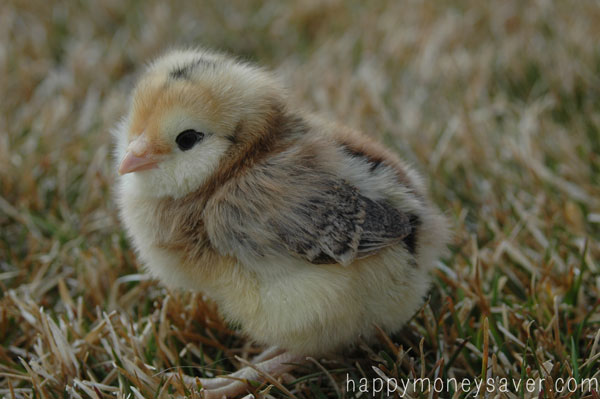Guidelines for Raising Baby Chicks
Posted by CaliforniaHatchery.com on 7/5/2013
1) A heating lamp and brooder area- The heating lamp temperature should change according as your chicks grow. Follow the heating lamp temperature guidelines below to provide optimal temperature for your chicks:
Week 1- 90-95 degrees fahrenheit
Week 2- 85-90 degrees fahrenheit
Week 3- 80-85 degrees fahrenheit
Week 4- 75-80 degrees fahrenheit
Week 5,6,7- 70-75 degrees fahrenheit
Week 8- 65-70 degrees fahrenheit
Week 9- 65 degrees fahrenheit
 The heating lamp should be placed 12-18 inches above the floor
of the heating area. Some signs that your heat is too low- Your chicks
will huddle together in the brooder. If the temperature is too high,
your chicks may be dispersed throughout the heating area, and they may
look tired. If the temperature is set correctly, your chicks will be
evenly dispersed throughout the heating area, and they will look lively
while making lots of peeping sounds!
The heating lamp should be placed 12-18 inches above the floor
of the heating area. Some signs that your heat is too low- Your chicks
will huddle together in the brooder. If the temperature is too high,
your chicks may be dispersed throughout the heating area, and they may
look tired. If the temperature is set correctly, your chicks will be
evenly dispersed throughout the heating area, and they will look lively
while making lots of peeping sounds!
2) Fresh water should always be made available to your chicks or ducklings
3) Non-medicated organic starter feed (offered through californiahatchery.com)
4) A stable surface (preferably with wood chips) for your chicks or ducklings to move upon. Make sure to clean the brooder area at least twice a day
VERY IMPORTANT Chick Care Instructions |
| Raising baby chicks is easy!You should
first consider where to keep your baby chicks before placing your order. We recommend setting up a brooder house which can be
anything from a cardboard box to an actual building depending on the
size of your soon-to-be-acquired flock. The area should be kept clean,
dry and draft free. Prepare your brooder before ordering your chicks.
Brooder Surface
For the first 4 or 5 days after they hatch put the chicks on a non slippery surface. Hardware cloth is the recommended surface of choice. The non slippery surface will help the chicks learn to walk and aids in preventing sprained legs. Once the chicks have a few days on this surface and have figured out the source of their chick feed, spread some type of litter on the floor 2 to 4 inches deep. Wood shavings work well for this purpose and attention should be given to keeping the litter clean and dry. Chick Heating Lamp and Brooder An infrared Heat Lamp will keep your chicks warm. California Hatchery offers a Red Heating Bulb as this will cause less pecking. Initially the temperature should start at 95 degrees and lowered 5 degrees each week until 70 degrees is reached. At this point the heat can be removed unless the temperatures outside the brooder area are still quite cold. Position your lamp so that it will maintain the proper temperature, yet not pose a threat to igniting the litter or burning the chicks. The chicks are the best indicators of whether or not you are providing them with adequate heat. If they are all huddled together under the lamp you need to increase the heat in the brooder. Conversely, if they break off into little groups well outside the lamp, it's too hot. Ideally your chicks should be feeding and drinking and generally scattered about the brooder area. Food and water should also be provided to your baby chicks. We recommend dipping the chick's beaks in their water and feed to familiarize them to their food and water source. The available water supply should "grow" with your chicks. You will need an adequate number of containers to accommodate the size of your flock. As the chicks grow their consumption increases and you will need to increase their water supply. Initially the chicks will need a small water supply of some type with marbles or small pebbles placed in it to keep them from swimming. Water is vital to the chicks survival, but being wet is not! The same basics hold true for your feeders. The bigger the chicks get the larger feeder you will need. Your chicks should be fed Chick Starter Feed, which is available to order from our website. This feed contains approximately 23% protein for young chicks, and is non-medicated. After about 18 weeks, you can switch to our Layer Developer Feed which contains about 17% protein for older chicks and young chickens. |
.
..
No comments:
Post a Comment